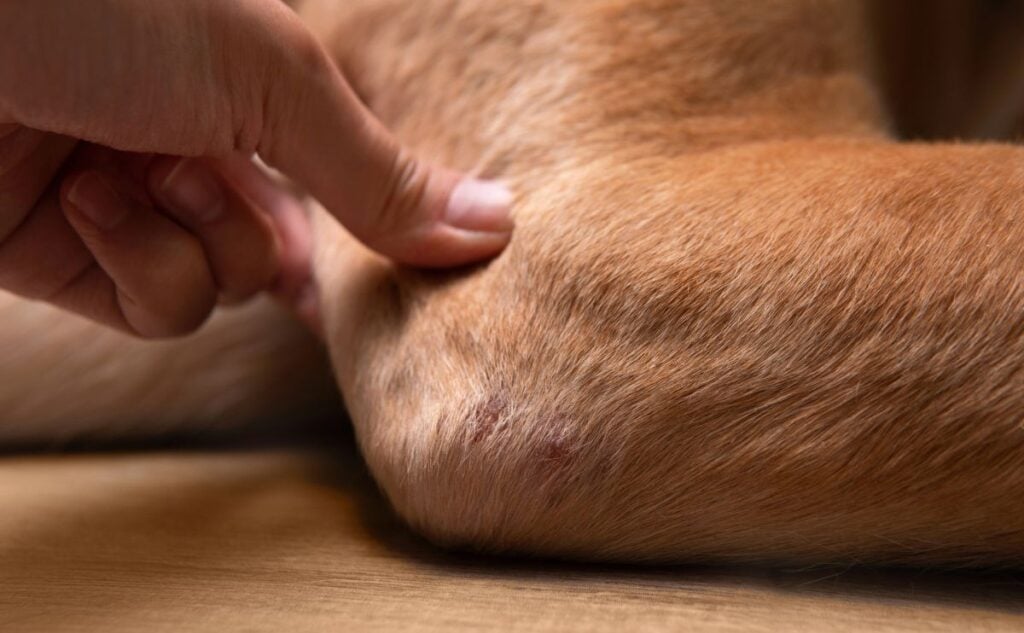Is Your Dog In Silent Pain? How To Spot & Treat Arthritis Before It’s Too Late
When you purchase through links on our site, we may earn a commission. Here’s how it works.
Is your pup hesitating on the stairs? Skipping walks? Or suddenly stiff after a nap? These might look like harmless signs of aging, but they could actually be early symptoms of arthritis in dogs. It is a common yet often overlooked condition that affects millions of pets, especially as they get older.
Table of Contents
Dog arthritis isn’t just about sore joints; it’s a progressive condition that can quietly chip away at your pet’s mobility, mood, and quality of life if left unaddressed. The good news is that there are more vet-approved treatments, natural remedies, and supportive care options than ever before.

In this guide, you’ll learn how to recognize the subtle signs of arthritis before they escalate, understand the best treatment options available, and explore real-life solutions to help your dog move more freely and feel better every day. So, let’s dig in and help your pup get back to tail wags, long walks, and playful zoomies with less pain and more joy.
What Is Arthritis In Dogs?
If you’ve ever watched your dog hesitate before jumping onto the couch or taking a little longer to stand up after a nap, you’ve seen the quiet signals of canine arthritis. Just like humans, dogs can experience joint inflammation and stiffness, especially as they age. Arthritis is one of the most common chronic conditions in dogs. It doesn’t just affect older pups; injuries, genetics, and even obesity can speed up its onset.
So, what exactly is arthritis in dogs? At its core, it’s a degenerative joint disease that causes the cartilage, which is the cushioning between bones, to wear down over time. As that padding breaks down, bones start to rub against each other, leading to pain, swelling, and reduced mobility.
The tricky part? Dogs are masters at hiding discomfort. You might not notice symptoms until the disease has already progressed. That’s why early awareness and proactive care are so important. With the right treatment plan and lifestyle adjustments, many dogs with arthritis can still enjoy an active and happy life.
Types Of Arthritis In Dogs
Not all forms of arthritis in dogs are the same. In fact, there are several different types, each with its own unique causes, symptoms, and treatment approaches. Knowing which type your dog might be facing is key to managing their care and keeping them comfortable in the long term.
Osteoarthritis In Dogs
Osteoarthritis (OA) in dogs, also referred to as degenerative joint disease (DJD), is typically caused by normal wear and tear. The cartilage inside the joint gradually breaks down, leading to bone-on-bone friction. That’s where the pain, stiffness, and swelling come from. This wear and tear on the joints can be attributed to factors such as age, body weight, activity level, and genetics.
OA is a common problem in older dogs and can range from mild, such as hearing the click of a knee, to severe, like hip dysplasia, a genetic disease. Dogs with osteoarthritis may move more slowly, seem reluctant to play, or limp after lying down for a while. The Canine Health Foundation reports that osteoarthritis affects approximately one in five adult dogs in the United States.
Large breeds, such as German Shepherds, Golden Retrievers, and Labrador Retrievers, are more prone to developing osteoarthritis than smaller dogs. However, OA can affect any size or breed of dog, particularly if your dog is highly athletic or obese. The heavier a dog is, the greater the pressure on their joints.
Rheumatoid Arthritis In Dogs (Autoimmune)
Rheumatoid arthritis (RA) is an autoimmune disease that causes the body to go into hyperdrive, mistakenly attacking healthy tissue and progressively wearing away the cartilage in joints. It can also be caused by an infection, such as bacterial or fungal infection, tick-borne disease, or Rocky Mountain spotted fever.
RA tends to cause more widespread joint pain and inflammation and can occur suddenly, even in younger dogs. It is less common in dogs than OA. This disease affects multiple joints and typically occurs in small, toy, or miniature breeds, usually beginning at five or six years old; however, it can also affect larger breeds.
Rheumatoid arthritis can affect multiple joints simultaneously and can be more challenging to manage. Diagnosis typically involves blood tests, X-rays, and a more thorough evaluation by your veterinarian. While it is rarer, catching this early and beginning treatment promptly is crucial to prevent permanent joint damage.
Causes & Risk Factors Of Arthritis In Dogs
Ever wonder why some dogs develop arthritis while others seem to stay spry into their senior years? Just like in humans, arthritis in dogs isn’t caused by one single thing. It is usually the result of a combination of genetics, lifestyle, age, and previous injuries.
Here are the most common culprits behind those stiff joints and sore hips:
Breed & Genetic Predisposition
Some dogs are more likely to develop canine arthritis due to their breed. Larger breeds, such as Labrador Retrievers, Golden Retrievers, German Shepherds, and Rottweilers, tend to carry more weight and experience greater stress on their joints. Breeds with structural issues, like Bulldogs or Dachshunds, may also develop arthritis earlier due to bone and joint misalignments.
Aging & Wear-and-Tear
Age is the most obvious risk factor. As dogs age, the cartilage that cushions their joints begins to thin and break down. This natural degeneration can lead to chronic inflammation and discomfort, especially if your pup has been very active or has a history of joint stress.
Obesity & Poor Nutrition
Carrying extra weight puts a lot of pressure on your dog’s joints, especially the hips, knees, and elbows. In fact, overweight dogs are significantly more likely to develop arthritis and will often show signs earlier than leaner dogs. A poor diet lacking essential nutrients for joint health, such as Omega-3s or glucosamine, can exacerbate the condition.

Previous Injuries Or Joint Conditions
Dogs that have suffered joint injuries, like torn ligaments, fractures, hip dysplasia, or elbow dysplasia, are at higher risk of developing secondary osteoarthritis. Even a minor injury early in life can lead to inflammation and long-term wear on the joint.
Overuse Or High-Impact Activity
Very active dogs, like working breeds, agility dogs, or fetch fanatics, can develop arthritis earlier due to repetitive stress on their joints. While exercise is crucial for joint health, high-impact activities without proper rest can lead to inflammation over time.
Understanding your dog’s risk factors can help you take preventive steps early, such as managing their weight, using joint supplements, or adjusting their activity level long before arthritis becomes painful or disabling.
Early Signs & Symptoms Of Arthritis In Dogs
Dogs can’t tell us when something hurts, but they do show us. The trouble is that many signs of arthritis in dogs start off subtly. A lot of pet parents chalk up changes in behavior to “just getting older,” when in reality, their pup may be dealing with chronic joint pain.
Knowing the early symptoms can make a world of difference in getting your dog relief sooner and slowing the progression of arthritis over time. Osteoarthritis and rheumatoid arthritis share many similar symptoms because both conditions involve the degeneration of joints. Here are signs of arthritis in dogs:
- Slow to get up
- Stiffness after rest, especially in the morning or after long naps
- Favoring a limb
- Limping that may come and go
- Hesitancy in actions that were previously easy (climbing steps, jumping up, running)
- A decrease in activity or play
- Lying down and/or sleeping more frequently
- Enlarged lymph nodes (in rheumatoid arthritis)
- Swollen joints or signs of discomfort when touched
- Changes in posture or a noticeable shift in gait
- Irritability or withdrawn behavior, especially when movement is involved
- Licking or chewing joints, often around the wrists, knees, or hips
Some dogs may also pant more than usual or have trouble getting comfortable when lying down. You might even notice they’re showing less enthusiasm or seeming “off” in a way you can’t quite explain. It’s essential to take note of these signs as soon as you first notice them and visit your veterinarian if symptoms persist to receive a diagnosis and treatment.
Tip: Remember that dogs are animals, and it’s part of their instinct to not outwardly show pain or weakness that would reveal vulnerability to a predator in the wild. Because dogs often do not display the initial signs of soreness and discomfort, by the time we notice them having difficulty with their stride or ability to get up, arthritic changes in their joints may have progressed significantly.

Why Early Detection Matters
The earlier you notice arthritis symptoms in your dog, the more options you’ll have to slow its progression. From joint supplements and physical therapy to adjustments in diet and daily routines early intervention can make all the difference between discomfort and a full, active life.
Even if your dog is young, don’t ignore small shifts in their behavior or energy. Arthritis can sneak up earlier than expected, especially in breeds prone to joint issues or pups carrying extra weight.
Behavioral & Emotional Effects Of Arthritis
Dogs don’t just feel arthritis in their joints. They feel it in their whole being. If your pup is in pain, it’s not just their body that suffers. Arthritis can also take a toll on your dog’s mood, personality, and emotional well-being, often in ways that are easy to miss.
Pain changes behavior, and with dogs, those changes can be subtle.
Signs Your Dog May Be Struggling Emotionally
Maybe your usually happy, social pup is suddenly more withdrawn. Or perhaps they’ve become snappy, especially when touched near their legs or back. These are red flags.
Here are some of the most common behavioral signs of chronic pain in dogs with arthritis:
- Irritability or aggression, especially when being picked up or moved
- Avoiding interaction, such as hiding, sleeping alone, or resisting play
- Excessive licking or chewing of specific joints
- Increased restlessness or pacing, particularly at night
- Sudden vocalizations like whining or yelping when shifting position
- Clingy or anxious behavior. Your dog might shadow you more than usual
Some dogs may even appear depressed. They stop greeting you at the door. They lose interest in their favorite toys. It’s heartbreaking, but it’s also something you can address once you know what’s happening.
What These Behaviors Are Telling You
Behavioral shifts are often your dog’s way of saying, “Something’s not right.” Dogs instinctively hide pain, so by the time they show emotional changes, their discomfort might already be significant. If you notice any of these changes, it’s time to consult your veterinarian. Managing your dog’s pain through medication, physical therapy, or even slight changes at home can drastically improve both their mood and mobility.
Diagnosing Arthritis In Dogs
If you’ve noticed signs of stiffness, limping, or behavioral changes, the next step is getting a proper diagnosis, and that means a visit to the vet. While some symptoms of dog arthritis are obvious, many are subtle and can easily be mistaken for fatigue, aging, or even mood swings.
What To Expect At The Vet
When you first take your dog to the veterinarian after seeing the symptoms of arthritis, your vet will examine your dog in a few ways to see what might be causing the trouble.
Be prepared to talk with your vet about all the symptoms you’ve observed in your dog’s behavior. Your vet will want to know which symptoms you’ve noticed, when they started, and how severe they are. This discussion will play a crucial initial role in the diagnostic process and will greatly assist your veterinarian in making their diagnosis.
Other diagnostic tests include:
- Manual examination of your pet’s legs to determine which joints are affected.
- X-rays of the affected joint to help confirm (or rule out) the presence of arthritis as the cause of pain or decreased mobility. X-rays can also reveal how arthritis is affecting the joints, such as increased joint fluid and a narrowed joint space.
- Bloodwork and urine samples to determine if an infection is the problem with the joint or if other medical issues are causing your dog discomfort.
- A sample of synovial fluid from the affected joints may also be necessary to determine the cause of your dog’s arthritis.
Remember, arthritis doesn’t go away on its own. But it can be managed, sometimes incredibly well, with the right plan.

Pet Insurance Can Help You And Your Pup
You may want to consider signing up for pet insurance as a proactive measure to lower your financial risk for potential health threats, like arthritis, during your dog’s lifetime. Why? Pet insurance is one of the best things you can do for your dog. Not only for the health of your pup but to save you from financial trouble should an accident, illness, or pet emergency arise.
Humans have health insurance, so our furry friends should, too. That way, you’ll never have to choose between an expensive treatment and your pet’s suffering or even their life. Pet insurance gives you peace of mind, allowing you to make better, more informed decisions in the face of a crisis.
Check out our comparison of the top pet insurance companies to learn more, or get a free quote below.

Claim Reimbursement Stories
- Dog: Robbie, a 6-year-old male Labrador mix
- Conditions: Soft tissue injuries, Arthritis, Hypothyroid, Growth on the face (bacterial)
- Total Vet Cost: $7,949.84
- Total Reimbursed By Trupanion: $6,726.58
Unfortunately, arthritis isn’t preventable, but there are ways to manage it. Here’s another claim scenario from another pet insurer.
- Dog: Pilot, 11-year-old yellow Labrador Retriever
- Condition: Arthritis
- Total Vet Cost: $147.73
- Total Reimbursed By Fetch: $132.96
- Policyholder Paid: $14.77
Veterinary Research & Arthritis Statistics
We often think of arthritis as an old-dog problem, but research tells a more urgent story. Arthritis in dogs is not only incredibly common, but it often goes undiagnosed until the condition becomes advanced and more painful.
According to studies published in Frontiers in Veterinary Science, over 20% of dogs over the age of one suffer from osteoarthritis., with that number climbing dramatically in senior pets and larger breeds. And here’s the kicker: many dogs show signs as early as age five, especially if they’re overweight, have a history of injury, or are genetically predisposed.
A collaborative study from the Universities of Glasgow and Utrecht found that weight loss alone significantly improved mobility and reduced lameness in obese dogs with osteoarthritis. That means lifestyle changes, not just medication, can play a powerful role in managing this disease.
Other studies have shown that neutered dogs are also more likely to experience arthritis. Lastly, and possibly most importantly, research has also found that having these joint issues can lower a dog’s lifespan. These studies and statistics highlight the importance of understanding and managing your pup’s arthritis, thereby keeping them with us for longer.
Why Research-Backed Care Matters
Science-backed care isn’t about overwhelming you with numbers; it’s about empowering you with confidence. The more we understand the patterns of arthritis in dogs, the more effective (and personalized) treatment plans can become. By choosing evidence-based therapies and staying informed, you can help your pup not just live longer but move better and feel happier along the way.
Dog Arthritis Treatment Options
The good news? Arthritis in dogs is highly manageable. While there’s no “cure,” modern veterinary medicine, and even some holistic options, offer a wide range of treatments that can significantly reduce pain, improve mobility, and help your dog feel like themselves again.
You may be wondering, ‘What can I give my dog for arthritis?’ Fortunately, there are a variety of ways to treat your dog’s arthritis, including nutritional supplements, food, medications, complementary therapies, and surgery for severe cases. Whichever you choose, it’s most important to discuss the options with your vet and agree on a plan, which may involve a combination of these treatment options. As with other pet health treatments, don’t take action without first consulting a vet.
Prescription Medications For Dog Arthritis
Arthritis medicine for dogs is prescribed by your vet to control signs of arthritis, including inflammation, swelling, stiffness, and joint pain. Non-steroidal anti-inflammatory drugs (NSAIDs) are frequently prescribed for managing arthritis in dogs. Some common ones are Rimadyl, Metacam, and Deramaxx.
Never give your dog NSAIDs meant for humans. Although we may have human NSAIDs in our medicine cabinets, it is essential to use a vet-prescribed medication and dosage for your dog. Misuse of human NSAIDs with dogs can have adverse side effects on your dog, such as gastrointestinal bleeding, gastric ulcers, kidney or liver dysfunction, and even death.
Natural Remedies & Nutritional Supplements
If you’re looking to support joint health naturally, you’re not alone. Many pet parents successfully manage arthritis with veterinarian-recommended joint supplements, including:
Glucosamine & Chondroitin Sulfate For Arthritis
Glucosamine and chondroitin sulfate are the most commonly used supplements that help decrease joint inflammation and improve the body’s ability to repair and strengthen tissues. It is a naturally occurring compound made of sugar and an amino acid that’s involved in the body’s natural production of joint lubricants. It’s extracted from crab, lobster, and shrimp shells. Learn more about glucosamine for dogs.
Chondroitin sulfate is composed of omega fatty acids, vitamin E, and selenium that work together to help repair damaged joint cartilage and can prevent future breakdown by keeping cartilage hydrated. Some studies have shown that combining glucosamine and chondroitin sulfate can enhance the beneficial effects of both.
I recommend these NaturVet Glucosamine-DS tablets, which include 500mg of glucosamine per tablet. They also contain chondroitin and omega-3 and omega-6 fatty acids from fish oil and flaxseed.
Methylsulfonylmethane (MSM) For Arthritis
Methylsulfonylmethane (MSM) is a chemical found in plants, animals, and humans that supplies sulfur to the system. Scientists believe that it may create other chemicals in the body. MSM is used to relieve chronic pain and arthritis.
I recommend these Zesty Paws Multivitamin Chews, which include glucosamine, chondroitin, and methylsulfonylmethane (MSM). As a multivitamin, they also contain additional ingredients to support various bodily functions, including digestion, skin and coat health, overall wellness, and more.
Green-Lipped Mussels For Arthritis
A green-lipped mussel, called Perna canaliculus, is a type of sea cucumber that can help minimize pain and provide nutrients that support cartilage health. I recommend the VetriScience GlycoFlex 3 Hip and Joint Support supplement, which includes glucosamine, Perna canaliculus, MSM, and other ingredients.
Bosweillia For Arthritis
Boswellia serrata is a natural anti-inflammatory herb known for its joint-soothing properties. It may help reduce swelling, ease stiffness, and improve mobility, especially in older dogs with mild to moderate hip or joint discomfort. While it’s not a cure, many pet owners and veterinarians find it a gentle and effective addition to a broader arthritis care plan. I recommend these NaturVet S.O.D and Boswellia capsules.

Our Personal Experience With Dog Arthritis
Bonkers, my 11-year-old pup, has always been a bundle of goofy energy, true to his name. But over the past few months, I started noticing some subtle (and honestly, heartbreaking) changes. He was a little slower to get up after long naps, his back legs seemed stiff, and every now and then he’d stumble slightly or miss a step during our walks. At first, I chalked it up to normal aging, but my gut told me to check in with our vet.
Sure enough, after a gentle exam and some joint manipulation, the vet confirmed that Bonkers has arthritis in his hips. Thankfully, it’s not severe enough (yet) to require prescription medications or more invasive treatments, but it was enough to impact his comfort and mobility.
Our vet recommended trying Boswellia supplements, a natural anti-inflammatory. I’ve been giving them to Bonkers daily for about two months now, and while I know it’s not a magic fix, I’ve honestly noticed a difference. He’s less stiff when he stands, seems more eager to move around, and has started with his crazy zoomies again.
– Emma Braby, Dog Mom & Writer For Canine Journal
Catch Bonkers in action, zoomies mode activated!
CBD Oil For Arthritis
CBD oil has become a popular natural option for managing arthritis pain in dogs. It can help to reduce inflammation, ease joint discomfort, and improve mobility. Especially when used alongside traditional treatments like NSAIDs or supplements. However, not all CBD products are created equal. It’s crucial to choose a vet-recommended, THC-free formula made specifically for pets. Always consult your veterinarian before starting a CBD regimen to ensure it is safe and dosed appropriately for your dog’s size and health condition.
We have researched and tested several different dog CBD oils and CBD treats that may help your pup manage their arthritis. Discover the benefits of CBD for dogs in our dedicated guide. Plus, you can visit HolistaPet’s website, which is our top-rated CBD company for dogs.
We have a comprehensive guide on arthritis supplements for dogs, offering more information, tips, and highly recommended supplements for canine arthritis.
Exercise, Physical Therapy, & Complementary Therapies
Most vets agree that movement (within your dog’s comfort zone) is good for joint health and mobility. Often, a lack of daily exercise can cause joint stiffness and lead to weight gain, which in turn puts more stress on your dog’s joints.
Your vet may recommend regular physical therapy, which you can also do at home in between therapy sessions, to reduce joint pain. Regular walks will help to keep your dog at a healthy weight. Remember to consult your vet about the exercise and eating habits that are best for your dog.
Complementary therapies for arthritis include massage, acupuncture, acupressure, laser treatment, water therapy, and chiropractic medicine. These therapies can be powerful additions, especially for dogs with mild to moderate arthritis, or as post-surgical recovery tools.
Surgery For Advanced Arthritis
Sometimes, a dog’s arthritis becomes so severe that surgery is the best treatment option to relieve joint pain and inflammation. There are different surgical techniques for treating arthritis, so your vet will decide what type of surgery will be best for your dog. These include:
- Arthroscopy. Minimally invasive cleanup of damaged joints
- Joint Fusion or Replacement. Used in extreme cases, especially for hips and elbows
Surgery isn’t always necessary, but for some dogs, it can be life-changing. Your vet or a veterinary orthopedic specialist will help assess if it’s the right move.
Choosing The Right Treatment Plan For Arthritis
The truth is, there’s no one-size-fits-all solution for arthritis in dogs. The best treatment plan depends on your dog’s age, breed, activity level, the severity of their arthritis, and even their personality. Some dogs thrive with conservative management, while others may require a combination of medications, physical therapy, and lifestyle adjustments to remain comfortable.
Think of arthritis care as a long-term, evolving process. What works today may need fine-tuning tomorrow. That’s why regular vet check-ins are so important, especially if you notice changes in your dog’s mobility, appetite, or mood.
And don’t underestimate the impact of small, consistent changes: switching to an orthopedic bed, modifying daily exercise routines, or adding anti-inflammatory foods can all contribute to better outcomes.
Tools To Help Your Arthritic Dog
As arthritis progresses, your dog will likely experience trouble getting around. These tools can help improve your dog’s daily mobility and quality of life.
Orthopedic Dog Beds
Think of this as your dog’s recovery zone. Orthopedic or memory foam beds provide much-needed joint support and relieve pressure points, especially for dogs with hip or elbow pain. We have a guide on the best orthopedic dog beds, with tips on finding the right one for your pup and our top-rated options.
Dog Boots
Have slippery floors in your home? Non-slip dog booties can help with stability on slick hardwood or tiled floors. The Lonsuneer Dog Boots come in five sizes and have an adjustable closure so they don’t slip off of your dog’s paws. They’ll keep your dog’s paws cool and dry and help him maneuver through your home like normal. Non-slip rugs can be particularly helpful, too, if you have hard floors.
Harness Sling
If your dog is suffering from crippling arthritis in their hips or rear legs, using a pelvic harness/sling is a great way to help your dog with mobility. The vet-recommended Walkabout Back End Harness fits comfortably around your dog’s abdomen and back legs, featuring a handle for easy lifting of their back end. It comes in seven sizes, allowing you to find the perfect fit.
Wheelchair For Dogs
If your dog’s arthritis is severe, you may want to consider a dog wheelchair to help them get around more easily. However, your dog’s muscles will atrophy (become smaller) much more quickly while using a wheelchair. Therefore, it is essential to use it only after consulting with your veterinarian and after trying other options without success.
Joint-Friendly Exercises & Mobility Routines
Here’s something encouraging: movement is medicine for arthritic dogs, as long as it’s the right kind of movement. While high-impact activity can aggravate joint pain, low-impact, consistent exercise actually helps reduce stiffness, support joint health, and strengthen muscles that keep your dog mobile.
The key is to strike a balance between keeping your pup active without overdoing it.
Best Exercises For Dogs With Arthritis
- Leash Walks on Soft Surfaces. Short, gentle walks (10–20 minutes) a few times a day on grass or dirt paths are easier on the joints than one long, tiring walk.
- Swimming or Hydrotherapy. Water workouts are a gold standard for dogs with arthritis. They allow for full-body exercise without putting weight on sore joints, and many dogs love it.
- Slow Incline Walking. Gentle hills or ramps help build hind-leg strength without jarring impact, but skip stairs if your dog struggles with balance.
- Range of Motion (ROM) Exercises. Guided by a veterinarian or canine rehabilitation specialist, these exercises help maintain flexibility and prevent muscle loss in stiff joints.
Exercise Tips To Maximize Comfort
- Warm-up First. Let your dog stretch and move around slowly before heading out.
- Watch for Fatigue. Limping, lagging, or sitting down mid-walk are signs to take a break.
- Skip Fetch Marathons. High-speed starts and stops are tough on arthritic joints.
- Keep it Consistent. Daily movement, even just a little, matters more than weekend “catch-up” sessions.
When dogs stop moving due to pain, joints stiffen, muscles weaken, and inflammation builds, making arthritis worse. Gentle exercise helps break that cycle. And just as importantly, it boosts your dog’s mental well-being, giving them a sense of normalcy and routine.
Preventing Arthritis In Dogs
While you can’t always stop arthritis, especially when genetics are involved, you can slow it down. In fact, many of the same things used to treat arthritis are even more powerful when used preventively. Whether your dog is a playful puppy or a middle-aged couch cuddler, a few minor changes now could mean a more active, pain-free life later on.
Keep Your Dog At A Healthy Weight
This is the most critical step in preventing arthritis. Excess weight puts added strain on your dog’s joints, especially the hips, knees, and elbows. Studies show that maintaining a lean body condition can significantly delay the onset and severity of canine osteoarthritis.
Use a vet-approved feeding plan and ensure your dog receives regular, low-impact exercise that supports joint health without overexertion.
Start Joint Supplements Early
Don’t wait for the limp to start. Vets often recommend glucosamine, chondroitin, and omega-3 fatty acids for large breeds, senior dogs, or pups with a family history of joint problems, even before symptoms show up.
Encourage Safe, Regular Movement
Arthritis doesn’t like movement, but immobility makes it worse. Encourage gentle, consistent exercise like leash walks, light fetch sessions, or swimming (if your dog enjoys it). Avoid repetitive high-impact activities like stair running or intense jumping, especially in growing puppies.
Regular Vet Checkups Matter
Annual (or biannual for older dogs) checkups allow your veterinarian to monitor joint health, weight, and early signs of arthritis before they become a more significant issue. Vets may also suggest baseline X-rays for at-risk dogs to track any slow changes over time.
Preventing arthritis is all about being proactive. The earlier you invest in joint health, the better the outcome will be. Not just for your dog’s mobility but for their overall happiness, confidence, and zest for life.
When To Consider Euthanasia For Dogs With Severe Arthritis
This is the hardest chapter for any pet parent, and it’s okay if you don’t want to read it all at once. But if your dog’s arthritis has progressed to the point where pain seems constant and daily life is a struggle, you may be wondering if it’s time to say goodbye. First, let it be said: there is no perfect time, only a compassionate one.
Euthanasia is never an easy decision, but in many cases of advanced, untreatable arthritis, it’s a deeply loving one. When treatments no longer help, and your dog’s pain outweighs their joy, helping them pass peacefully can be the final act of kindness.
The HHHHHMM Scale: A Quality of Life Checklist
Many vets use a framework called the HHHHHMM scale to help families evaluate a dog’s comfort across key areas. You can use this at home to guide conversations with your vet:
- Hurt – Is your dog in pain despite medication?
- Hunger – Are they eating regularly or losing interest in food?
- Hydration – Are they drinking enough and staying hydrated?
- Hygiene – Can they stay clean without excessive effort or discomfort?
- Happiness – Do they still enjoy interactions, play, or affection?
- Mobility – Are they able to move around enough to function and eliminate normally?
- More good days than bad – Is your dog still having more good days than not?
If multiple categories are declining, or if “bad days” are becoming the norm, it may be time to have that difficult conversation with your vet.
You Are Not Alone
Grieving in advance is real. Guilt is real. But so is the love you’ve shown in every vet visit, every pill given, every ramp added, every gentle walk taken. Choosing euthanasia is never giving up. It’s taking your dog’s side when they can no longer fight for themselves.
Consult with your veterinarian, discuss with your family, and trust your instincts. You know your dog better than anyone.
Explore More Ways To Support Your Dog’s Health
Arthritis is just one piece of your dog’s health journey, and you don’t have to face it alone. If you found this guide helpful, we have even more expert-backed advice on managing other common conditions in dogs. Whether it’s skin allergies, digestive issues, eye problems, cancer, or stress, we cover a wide range of health topics to help you find answers, solutions, and support across our site.
Has your dog battled arthritis? Share your story in the comments, as we’d love to hear how you’re helping your pup stay happy and mobile. Your experience could inspire and support another pet parent.
Why Trust Canine Journal
Sally brings over 20 years of experience in health sciences communication, with 10 years specifically focused on pet health and wellness. As a long-time dog owner and trusted contributor at Canine Journal, she works closely with a passionate team of canine experts to research and review the most effective solutions for common conditions like arthritis in dogs. From supplements and therapies to supportive gear and vet-approved treatments, Sally is dedicated to helping pet parents discover practical ways to enhance their dog’s comfort, mobility, and overall quality of life.



